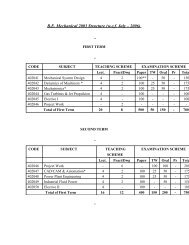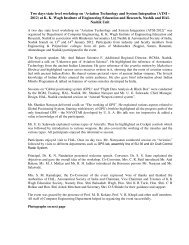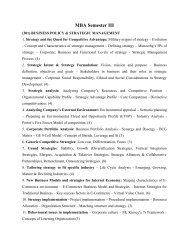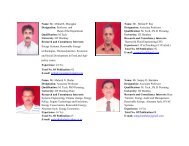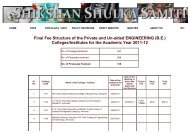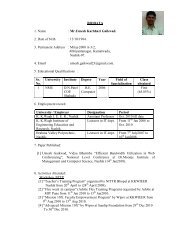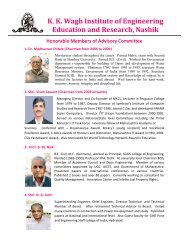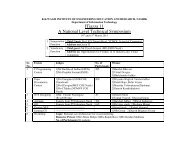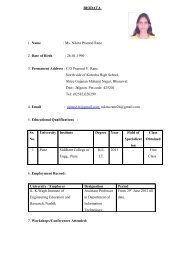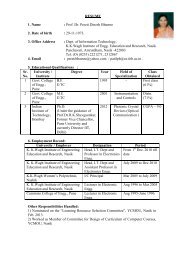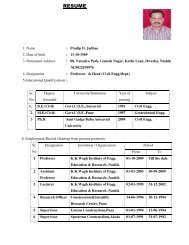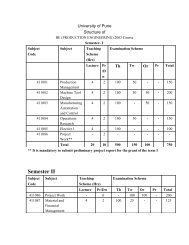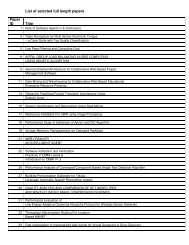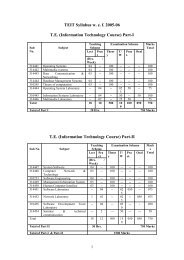2003 Course - K. K. Wagh Education Society
2003 Course - K. K. Wagh Education Society
2003 Course - K. K. Wagh Education Society
Create successful ePaper yourself
Turn your PDF publications into a flip-book with our unique Google optimized e-Paper software.
Structure of B.E (<strong>2003</strong> <strong>Course</strong>):-<br />
Detail B. E. Comp Syllabus<br />
Term I<br />
Subject<br />
Code<br />
Subject<br />
Teaching<br />
Scheme<br />
Examination Scheme<br />
Lect. Pract Th Tw Pr Or<br />
Mark<br />
410441 Design & Analysis of 04 100 ¾ 100<br />
Algorithms<br />
410442 Operating Systems 03 ¾ 100 ¾ ¾ ¾ 100<br />
410443 Object Oriented Modeling 03 02 100 25 ¾ 50 175<br />
& Design<br />
410444 Principles of Compiler 04 ¾ 100 ¾ ¾ ¾ 100<br />
Design<br />
410445 Elective I 04 02 100 25 ¾ 50 175<br />
410446 Computer Laboratory I ¾ 04 ¾ 50 50 ¾ 100<br />
410447 Project Work ¾ 02 ¾ 50 ¾ ¾ 50<br />
Total 18 10 500 100 50 100 800<br />
Term II<br />
Subject<br />
Code<br />
Subject<br />
Teaching<br />
Scheme<br />
Examination Scheme<br />
Lect. Pract Th Tw Pr Or<br />
Mark<br />
410448 Networks and 04 02 100 ---- ¾ ---- 100<br />
Information Security<br />
410449 Advanced Computer 04 ¾ 100 ¾ ¾ ¾ 100<br />
Architecture and<br />
Computing<br />
410450 Software Testing and 04 ¾ 100 ¾ ¾ ¾ 100<br />
Quality Assurance<br />
410451 Elective II 04 02 100 25 ¾ 50 175<br />
410452 Computer Laboratory ¾ 04 ¾ 25 50 ¾ 75<br />
II<br />
410447 Project Work ¾ 06 ¾ 100 ¾ 50 150
Total 16 12 400 200 50 100 700<br />
Th: Theory Tw: Term Work Pr: Practical Or: Oral<br />
Elective I<br />
Elective II<br />
1) Image Processing 1) Distributed Systems<br />
2) Advanced Databases 2) Software Architecture<br />
3) Artificial Intelligence 3) Embedded Systems<br />
4) Multimedia Systems 4) High Performance Networks<br />
B.E. Computer <strong>2003</strong> <strong>Course</strong><br />
410441 Design And Analysis of Algorithms<br />
Teaching Scheme:<br />
Theory:4 Hours/Week<br />
Examination Scheme:<br />
Theory:100 Marks<br />
Duration: 3 Hrs<br />
Objectives :<br />
· To study and perform analysis of algorithms.<br />
· To study techniques/strategies in design of algorithms<br />
UNIT I:<br />
Introduction :<br />
‘O’,’?’ and ‘?’ asymptotic notations, Average, Best and Worst case analysis of<br />
algorithms for Time and Space complexity, Amortized Analysis, Solving Recurrence<br />
Equations, Proof Techniques: by Contradiction, by Mathematical Induction.<br />
Priority Queues : Heaps & Heap sort. 8<br />
Hours
UNIT II:<br />
Divide And Conquer And Greedy Strategy:<br />
Divide and Conquer: General Strategy, Exponentiation. Binary Search, Quick Sort and<br />
Merge Sort. Greedy Method ,General Strategy, Knapsack problem, Job sequencing with<br />
Deadlines, Optimal merge patterns, Minimal Spanning Trees and Dijkstra’s<br />
algorithm.<br />
9 Hours<br />
UNIT III:<br />
Dynamic Programming:<br />
General Strategy, Multistage graphs, OBST, 0/1 Knapsack, Traveling Salesperson<br />
Problem, Flow Shop Scheduling.<br />
7 Hours<br />
UNIT IV:<br />
Backtracking & Branch And Bound:<br />
Backtracking: General Strategy, 8 Queen’s problem, Graph Coloring, Hamiltonian<br />
Cycles, 0/1 Knapsack.<br />
Branch and Bound: General Strategy, 0/1 Knapsack, Traveling Salesperson Problem<br />
.<br />
UNIT V:<br />
8 Hours<br />
Parallel Algorithms:<br />
Computational Model, Basic Techniques and Algorithms (Complete Binary Tree, Pointer<br />
Doubling, Prefix Computation), Selection, Merging, Sorting Networks, Parallel Sorting,<br />
Graph Problems (Alternate Algorithm for Transitive Closure, All pairs shortest path)<br />
UNIT VI:<br />
8 Hours<br />
NP-Hard And NP-Complete Problems:
Algorithms, Complexity-intractability, Non-Deterministic Polynomial time (NP)<br />
Decision problems, Cooks Theorem.<br />
NP-Complete problems- Statisfiability problem, vertex cover problem.<br />
NP-Hard problems-graph, scheduling, code generation problems, Simplified NP Hard<br />
Problems.<br />
6 Hours<br />
Text Books:<br />
1. Bressard, “Fundamental of Algorithm.” , PHI<br />
2. Horowitz and Sahani, “Fundamentals of computer Algorithms”, Galgotia.<br />
References :<br />
1. Thomas H Cormen and Charles E.L Leiserson, “Introduction to Algorithm” PHI<br />
2. A. V. Aho and J.D. Ullman, “Design and Analysis of Algorithms”, Addison Wesley<br />
410442 Operating Systems<br />
Teaching Scheme<br />
Lectures: 3 Hrs/Week<br />
Examination Scheme<br />
Theory: 100 Marks<br />
Duration: 3 Hrs.<br />
Objectives<br />
• To study advanced concepts of operating systems<br />
• To study the comparison of different function of different OSs.<br />
UNIT I :<br />
Process synchronization and inter-process communication :
Background, Critical section problem, semaphores, classic problems of<br />
synchronizations, critical regions, monitors, OS synchronization 4<br />
Hrs<br />
UNIT II :<br />
Deadlocks: System model, deadlock characterization, methods for handling deadlocks,<br />
deadlocks detection, prevention, avoidance, recovery<br />
Protection: Goals of protection, domain of protection, Access matrix, Implementation<br />
of Access matrix, Revocation of access rights<br />
Security: Security problem, User authentication, program threats, system threats,<br />
securing system and facilities, Intrusion detection and cryptography<br />
UNIT III :<br />
6 Hrs<br />
System Architecture, User perspective, Operating System Services, Assumptions about<br />
hardware, Architecture of UNIX OS, Introduction to System Concepts, Kernel Data<br />
Structures, System Administration, Buffer Headers, Structure of the Buffer Pool,<br />
Scenarios for retrieval of a Buffer, Reading and Writing Disk Blocks, Advantages and<br />
Disadvantages of the Buffer Cache<br />
8 Hrs<br />
UNIT IV :<br />
Internal Representation of files: Inodes, Structure of a regular file, Directories,<br />
Conversion of a path name to an Inode, Super Block, Inode assignment to a new file,<br />
Allocation of Disk Blocks, Other file types,<br />
System Calls for the file system: open, read, write, file & Record Locking, lseek, Close,<br />
File Creation, Creation of Special Files, Change Directory and Change Root, Change<br />
Owner and Change Mode, stat and fstat, pipes, dup, mounting and unmounting file<br />
systems, link, unlink, file system abstrations, file system maintenance<br />
8 Hrs<br />
UNIT V :
Structures of processes: Process States and Transitions, Layout of System Memory, The<br />
Context of a process, Saving the context of a process, Manipulation of the process<br />
address space, Sleep,<br />
Process control: Process Creation, Signals, Process Termination, Awaiting Process<br />
Termination, Invoking other programs, The User ID of a process, Changing the size of a<br />
process, The shell, System boot and the init process,<br />
Process Scheduling and Time: Process Scheduling, System calls for time & clock 8<br />
Hrs<br />
UNIT VI :<br />
Memory Management Policies: Swapping, Demand Paging, a hybrid system with<br />
swapping and demand paging<br />
I/O Subsystem: Driver interfaces, Disk drivers, Terminal drivers, Streams<br />
Text Books:<br />
4 Hrs<br />
1. William Stallings, “Operating System-Internals and Design Principles ”, 5/e,<br />
Prentice Hall India, ISBN-81-297-01094-3<br />
2. Silberschatz, Galvin, Gagnes , “Operating System Concepts” 6/e , John Wiley &<br />
Sons, ISBN-9971-51-388-9<br />
Reference Books:<br />
1. Dhamdhre D. M.,“Operating Systems – A Concept-Based Approach”, Tata<br />
McGraw Hill Publications, 2 nd<br />
Edition-2006<br />
2. Andrew S. Tanenbaum, “ Modern Operating Systems”, 2/e, Prentice Hall India,<br />
ISBN-81-203-2063-8<br />
3. Maurice J. Bach, “The design of the UNIX Operating System”, Prentice Hall<br />
India, ISBN-81-203-0516-7<br />
410443 Object Oriented Modeling and Design
Teaching Scheme<br />
Lectures: 3 Hours /Week<br />
Practical: 2 Hours/Week<br />
Oral : 50 Marks<br />
Examination Scheme<br />
Theory : 100 Marks<br />
Term Work:25 Marks<br />
Duration: 3 Hrs.<br />
Objectives :<br />
• Introduction to Modeling and Design of software, firmware and business<br />
processes.<br />
• Introduce UML 2.0 and its diagrams as a modeling tool for large and complex<br />
systems.<br />
• Understand the concepts being modeled in UML<br />
UNIT I :<br />
Introduction to OMG Standards : MDA, MOF, XMI,CORBA , UML 2.0. UML History,<br />
UML 2.0 New Features.<br />
Rational Unified Process emphasizing Inception, Elaboration, Construction, Transition<br />
Phases. 4+1 View architecture, Architectural approaches : Use case Centric, Architecture<br />
driven, Iterative approach, OO Concepts Review .<br />
UNIT II:<br />
Introduction to UML. UML MetaModel. Extensibility mechanisms like stereotypes,<br />
tagged values, constraints and profiles. OCL.Overview of all diagrams in UML 2.0.<br />
UNIT III :<br />
Object diagrams , CRC method, Review of OO concepts.Class diagrams, Classes and<br />
Relationships, Interfaces and ports, Templates, Active Objects, Advanced relationships<br />
generalization, association, aggregation, dependencies. Composite structure diagrams<br />
including composite structures, collaborations.<br />
UNIT IV :<br />
Interaction diagrams. Interaction Overview diagrams including interactions, signals,<br />
exceptions, regions, partitions, Sequence diagrams, Communication diagrams.<br />
UNIT V :
State Machine diagrams, States, encapsulation of states, transitions, submachine, state<br />
generalization. Timing diagrams, Activity diagrams, Activities, sub activities, signals,<br />
exceptions, partitions, regions.<br />
UNIT VI :<br />
Support for modeling Architecture in UML. Package diagrams, Component diagrams,<br />
Deployment diagrams. Applications of UML in embedded systems, Web applications,<br />
commercial applications.<br />
All diagrams are to be assumed for UML 2.0 for each diagram the need, purpose,<br />
Concepts, Notation, Forward Engineering, Reverse Engineering & Application must be<br />
considered.<br />
Text Books.<br />
1. Grady Booch, James Rumbaugh, Ivar Jacobson “Unified Modeling Language User<br />
Guide”, The (2nd Edition) (Addison-Wesley Object Technology Series)<br />
(Hardcover)<br />
Reference Books :<br />
1. Joseph Schmuller “SAMS Teach yourself UML in 24 Hours”, Third edition.<br />
2. Martin Fowler, “UML Distilled: A Brief Guide to the Standard Object Modeling<br />
Language”, Third Edition (Paperback) ,Addision Wesley<br />
3. Dan Pilone, Neil Pitman “UML 2.0 in a Nutshell”, (In a Nutshell (O'Reilly))<br />
Paperback)<br />
4. Hans-Erik Eriksson, Magnus Penker, Brian Lyons, David Fado “UML 2 Toolkit<br />
(Paperback) “<br />
5. Jim Arlow, Ila Neustadt “UML 2 and the Unified Process : Practical Object-<br />
Oriented Analysis and Design” (2nd Edition) (Addison-Wesley Object<br />
Technology Series) (Paperback)<br />
6. Michael Jesse, James A. Schardt “UML 2.0 for dummies “<br />
7. Kendal Scott, Apress “Fast track UML 2.0 “<br />
Object Oriented Modeling and Design Lab<br />
Objectives of the Laboratory:<br />
• To learn how to understand the requirements of a system, its scope.<br />
• To learn good design, good modeling practices, document them and be able to<br />
discuss the pros and cons of your designs and models.
• To learn issues in modeling large, complex systems with example hypothetical<br />
systems<br />
• To learn concepts, best practices in software, firmware development today and<br />
explore UML 2.0 Basic And Advanced concepts and notation for the same:<br />
• To use UML 2.0 diagrams for modeling different aspects of a system throughout<br />
the SDLC lifecycle<br />
• To model an entire system using UML 2.0<br />
• To learn effective use of any CASE TOOL for UML 2.0.<br />
To meet above objectives teachers will help students choose a hypothetical system<br />
preferably either a commercial, web based or embedded system for modeling. The<br />
students will try and identify scope of such a system as realistically as possible.<br />
Students will learn to draw, discuss different UML 2.0 diagrams, their concepts,<br />
notation, advanced notation, forward and reverse engineering aspects. As far as<br />
possible draw as many diagrams for one single system, unless they are not<br />
applicable for the chosen system in which case other systems may be chosen for<br />
specific diagrams.<br />
Any 8 diagrams can be drawn using tool, the other diagrams can be drawn on<br />
paper. Optionally one may draw Interaction overview diagrams, timing diagrams,<br />
and composite structure diagrams, object diagrams for your system as study<br />
assignments, paper based assignment or in cases relevant even in CASE TOOL.<br />
The write-ups for any diagram can include small examples to cover notation that<br />
has not been referred to in your submitted diagram. Generally any UML diagram<br />
has accompanied document to explain the diagram further for example use case<br />
descriptions, non-functional requirements, scripts, notes, assumptions, project<br />
management aspects.<br />
Assignments:<br />
1. Choose a hypothetical system of significant complexity and write an SRS for the<br />
same.<br />
2. Draw one or more Use Case diagrams for capturing and representing requirements<br />
of the system. Use case diagrams must include template showing description and<br />
steps of the Use Case for various scenarios.<br />
3. Draw one or more Package diagram to organize and manage your large and<br />
complex systems as well as their complex models.<br />
4. Draw activity diagrams to display either business flows or like flow charts.
5. Draw basic class diagrams to identify and describe key concepts like classes, types<br />
in your system and their relationships.<br />
6. Draw advanced class diagrams to depict advanced relationships, other classifiers<br />
like interfaces.<br />
7. Draw sequence diagrams OR communication diagrams with advanced notation for<br />
your system to show objects and their message exchanges.<br />
8. Draw state machine to model the behavior of a single object, specifying the<br />
sequence of events that an object goes through during its lifetime in response to<br />
events.<br />
9. Draw component diagrams assuming that you will build your system reusing<br />
existing components along with a few new ones.<br />
10. Draw deployment diagrams to model the runtime architecture of your system.<br />
410444 PRINCIPLES OF COMPILER DESIGN<br />
Teaching Scheme<br />
Examination Scheme<br />
Lectures: 4 hrs/week<br />
Theory: 100 Marks<br />
Duration : 3 Hrs<br />
Objectives<br />
• To learn and understand the design of a compiler<br />
• To learn and use tools for construction of a compiler<br />
UNIT I:<br />
Introduction to Compiler:<br />
Translator issues, why to write compiler, compilation process in brief, front end and<br />
backend model, compiler construction tools, Interpreter and the related issues, Cross<br />
compiler, Incremental compiler, Boot strapping, byte code compilers<br />
Lexical Analysis<br />
Review of lexical analysis: alphabet, token, lexical error, Block schematic of lexical<br />
analyser, Automatic construction of lexical analyser (LEX), LEX specification and<br />
features.<br />
6 Hours<br />
UNIT II :<br />
Syntax Analysis<br />
Introduction: Role of parsers, Top<br />
down-RD parser, Predictive parsers, LL (k) parsers, Bottom up Parsers – Operator<br />
precedence parsers, shift-Reduce: SLR, LR (k), LALR etc. using ambiguous grammars,
Error detection and recovery, Automatic construction of parsers (YACC), YACC<br />
specifications<br />
Semantic Analysis<br />
Need of semantic analysis, type checking and type conversion 10<br />
Hours<br />
UNIT III :<br />
Syntax directed translation<br />
Syntax directed definitions,<br />
construction of syntax trees, bottom-up evaluation of S-attributed definitions, L-attributed<br />
definitions, Top-down translation, bottom-up evaluation of inherited attributes<br />
Intermediate Code Generation<br />
Intermediate languages, declarations, assignment statements, iterative statements, case<br />
statements, arrays, structures, conditional statements, Boolean expressions, back patching,<br />
procedure calls, Intermediate code generation using YACC 10<br />
Hours<br />
UNIT IV :<br />
Run Time Storage Organisation<br />
Source language issues, Storage organization and allocation strategies, for block<br />
structured and non block structured languages, Activation record, variable-length data,<br />
procedure parameters, nested procedures, access to non-local names, procedure Call and<br />
return, static and dynamic scope, Symbol Table organisation and management<br />
6 Hours<br />
UNIT V :<br />
Code Generation:<br />
Introduction: Issues in code generation, Target machine description, Basic blocks and<br />
flow graphs, next-use information, Register allocation and assignment, Dag representation<br />
of basic blocks, Peephole optimisation, Generating code from a DAG, Dynamic<br />
programming, Code generator-generator concept. 8<br />
Hours<br />
Unit VI :
Code Optimisation<br />
Introduction, Classification of optimisation, Principle sources Of Optimisation,<br />
optimisation of basic blocks, Loops in flow graphs, Optimising transformations: compile<br />
time evaluation, Common sub-expression elimination, variable propagation, code<br />
movement, strength reduction, dead code elimination and loop optimisation, Local<br />
optimisation, DAG based local optimisation. Global Optimisation: Control and data flow<br />
analysis, Computing Global Data flow information: meet over paths, Data flow equations,<br />
Data flow analysis, Iterative data flow analysis: Available expressions, live range<br />
identification<br />
Text Books<br />
8 Hours<br />
1. A V Aho, R. Sethi, J D Ullman, “Compilers: Principles, Techniques, and<br />
Reference Books<br />
Tools”, Pearson <strong>Education</strong>, ISBN 81 – 7758 – 590 – 8<br />
1. K. Cooper, L. Torczon, “Engineering a Compiler”, Morgan Kaufmann Publishers,<br />
ISBN 81 – 8147 – 369 – 8<br />
2. K. Louden, “Compiler Construction: Principles and Practice”, Thomson<br />
Brookes/Cole (ISE), <strong>2003</strong>, ISBN 981 – 243 – 694 – 4<br />
3. J. R. Levine, T. Mason, D. Brown, “Lex & Yacc”, O’Reilly, 2000, ISBN 81–7366<br />
– 062 – X<br />
4.S. Chattopadhyay, “Compiler Design”, Prentice-Hall of India, 2005, ISBN 81–<br />
203–2725-X.<br />
410445 Artificial Intelligence<br />
Teaching Scheme<br />
Lectures :4 Hrs/Week<br />
Examination Scheme<br />
Theory :100 Marks<br />
Practical. : 2 Hrs/Week Term Work : 25<br />
Marks<br />
Oral : 50 Marks<br />
Duration : 3 Hrs<br />
Objectives<br />
• To understand the concepts of Artificial intelligence
• To Learn and Understand the knowledge representation techniques for<br />
knowledgebase<br />
• To Learn and Understand the fundamentals of Neural Network<br />
UNIT I :<br />
Introduction<br />
Definition, What is A.I ? Foundation of A.I., History, intelligent Agents, Agent<br />
Architecture, A.I. Application(E Commerce, & Medicine), A.I. Representation,<br />
Properties of internal representation . Futures of A.I ,Production System , Issue in<br />
design of search Programs<br />
Logic Programming<br />
Introduction , Logic, Logic Programming, Forward and Backward resoning , Forward<br />
and Backward chaining rules 8<br />
Hrs<br />
UNIT II :<br />
Heuristic search techniques.<br />
Heuristic search, Hill Climbing, Best first search, mean and end analysis, Constraint<br />
Satisfaction, A* and AO* Algorithm.<br />
Game playing<br />
Minmax search procedure, Alpha beta cutoffs, waiting for Quiescence, Secondary<br />
search. 7 Hrs.<br />
UNIT III :<br />
Knowledge Representation<br />
Basic of Knowledge representation, Knowledge representation Paradigrams,<br />
Propositional Logic, Inference Rules in Propositional Logic, Knowledge representation<br />
using Predicate logic : Predicate Calculus, Predicate and arguments, ISA hierarchy,<br />
Frame notation , Resolution , Natural Dedication
Knowledge representation using non monotonic logic:<br />
TMS (Truth maintenance system), statistical and probabilistic reasoning, fuzzy logic,<br />
structure knowledge representation, semantic net, Frames, Script, Conceptual<br />
dependency. 10 Hrs<br />
UNIT IV :<br />
Learning:<br />
What is Learning? Types of Learning (Rote , Direct instruction Analogy, Induction,<br />
Deduction)<br />
Planning:<br />
Block world, strips, Implementation using goal stack, Non linear planning with goal<br />
stacks, Hierarchical planning, least commitment strategy.<br />
7 Hrs<br />
UNIT V :<br />
Advance AI Topics<br />
Naturat Language Processing<br />
Introduction, Steps in NLP , Syntactic Processing , ATN, RTN, Semantic analysis,<br />
Discourse & Pragmatic Processing .<br />
Perception : Perception, Action, Robot Architecture,<br />
8 Hrs<br />
UNIT VI :<br />
Neural Networks:<br />
Introduction to neural networks and perception-qualitative Analysis. Neural net<br />
architecture and applications.<br />
Expert system:
Utilization and functionality, architecture of expert system, knowledge representation,<br />
two case studies on expert systems.<br />
Text Books<br />
8 Hrs<br />
1. Eugene, Charniak, Drew Mcdermott: “Introduction to artificial intelligence.”<br />
2. Elaine Rich and Kerin Knight: “Artificial Intelligence.”<br />
3. Kishen Mehrotra, Sanjay Rawika, K Mohan; “Artificial Neural Network.”<br />
Reference Book<br />
1. Stuart Russell & Peter Norvig : “Artificial Intelligence : A Modern Approach”,<br />
Prentice Hall, 2 nd Edition.<br />
2. Ivan Bratko : “Prolog Programming For Artificial Intelligence” , 2 nd Edition<br />
Addison Wesley, 1990.<br />
3. Herbert A. Simon , “The Sciences of the Artificial “, MIT Press, 3 rd Edition ( 2 nd<br />
Printing ),1998.<br />
4. Tim Jones “Artificial Intelligence Application Programming” M. Dreamtech<br />
Publication<br />
Laboratory work:<br />
Assignment based on:<br />
1. Implement 8 puzzle problem using A* algorithm<br />
2. Implement AO* algorithm for tower of Hanoi<br />
3. Implementation of Unification Algorithm.<br />
4. Implementation of Truth maintenance system using prolog<br />
5. Implementation of Min/MAX search procedure for game Playing<br />
6. Parsing Method Implementation using Prolog.<br />
7. Development of mini expert system using Prolog / Expert System Shell “ Vidwan”<br />
Designed By NCST Mumbai.<br />
Staff should frame any six assignments on above topics.<br />
410445 Image Processing
Teaching Scheme<br />
Lectures: 4 Hours / Week<br />
Practical: 2 Hours / Week<br />
Theory: 100 Marks<br />
T/W: 25 Marks<br />
Examination Scheme<br />
Oral: 50 Marks<br />
Duration:3 Hrs.<br />
Objective:<br />
· Introducing The Concept Of Image In Digital Form<br />
· Analysis Of Digitized Images.<br />
· Processing And Restoration Of Images<br />
UNIT I :<br />
Introduction<br />
Scenes And Images, Application Of Image Processing, Image Processing System<br />
( Hardware, Software ) , Vector Algebra, Orthogonal Transform, Fuzzy Sets And<br />
Properties<br />
UNIT II :<br />
Image Formation And Digitization<br />
Geometric Model, Photometric Model, Sampling, Digitization , Elements Of Digital<br />
Geometry, Image Properties , Representation.<br />
UNIT III :<br />
Image Processing<br />
Image Enhancement – Contrast Intensification, Smoothening, Sharpening Image<br />
Restoration -- Square Error Restoration Techniques, Singular Value Decomposition,<br />
Homomorphic Filtering. Image Compressing – Basic – Lossy Compression, Loss-Less<br />
Compression
UNIT IV :<br />
Segmentation<br />
: Region Extraction, Thresholding, Texture Based, Histogram<br />
Analysis<br />
Edge Detection<br />
: Preventive Operators, Edge Filtering Masks<br />
Feature Extraction : Representation, Topological Attributes, Geometric Attributes,<br />
Spatial Features<br />
Recognition<br />
: Deterministic, Statistical ,Fuzzy<br />
UNIT V :<br />
Color image processing and Morphology<br />
Color Models, Pseudo coloring And Color Displays, Spatial Interpolation, Binary<br />
Morphology –Dilation, Crosion Thinning, Thickening And Pruning, Gray Level<br />
Morphology<br />
UNIT –VI :<br />
Application Of Image Processing<br />
Image Processing in Multimedia , Medical Images Capture And Processing, Satellite<br />
Imagery, Stereography, Water Marking<br />
Text Books :<br />
1. B. Chanda, D.Datta Mujumdar, “Digital Image Processing And Analysis”, PHI ,<br />
5 th Reprint ISBN-81-203-1618-5<br />
2. R.C. Gonzalez, R.R. Woods, “Digital Image Processing Person <strong>Education</strong> “, ISBN<br />
– 81-7808-629-8<br />
Reference:<br />
1. William Pratt, “Digital Image Processing”, John Willey & Sons Inc. , ISBN-9-<br />
814- 12620-9<br />
2. Anil Jain, “Fundamentals Of Digital Image Processing”, Anil Jain PHI, ISBN-81-<br />
203-0929-4
Image Processing Lab<br />
Assignments for Image Processing<br />
1. Develop C / C++ code to create a simple image and save the same as bitmap<br />
image in .bmp file.<br />
2. Develop C / C++ code to perform basic image enhancement operations like;<br />
sharing, smoothening using filtering masks<br />
3. Develop C/C++ code to implement image compression (any one algorithm)<br />
4. Implement grey scale thresholding to blur an image.<br />
5. Using derivative filtering technique implement an algorithm for edge detection<br />
and further thinning the edge.<br />
6. Mini Project: Instructor can give captured image from any of the application area<br />
and a group of students will be assigned a set of IP operations to analyze and<br />
extract all the features of the given image.<br />
The results (output) may be viewed and compared using any standard package.<br />
Students will submit the term work in the form of journal. The journal will contain<br />
minimum 5 assignments and a mini project. The instructor will frame atleast one<br />
assignment on each of the areas specified above. Oral examination will be based<br />
on the term work submitted.<br />
410445 Advanced Databases<br />
Teaching Scheme : Examination Scheme :<br />
Lecturers : 4 Hrs. / Week<br />
Practical : 2 Hrs / Week<br />
Theory : 100 Marks<br />
Term Work : 50 Mark<br />
Oral : 50 Mark<br />
Duration : 3 Hrs.<br />
Objectives :<br />
• To learn and understand advances in Database System Implementations<br />
• To learn and understand various database architectures and applications.<br />
UNIT I :<br />
Parallel databases
Introduction, Parallel database architecture, I/O parallelism, Inter-query and Intra-query<br />
parallelism, Inter-operational and Intra-operational parallelism, Design of parallel<br />
systems<br />
UNIT II :<br />
Distributed Databases<br />
Introduction, DDBMS architectures, Homogeneous and Heterogeneous Databases,<br />
Distributed data storage, Distributed transactions, Commit protocols, Concurrency<br />
control in distributed databases, Availability, Distributed query processing , Directory<br />
systems<br />
UNIT III :<br />
Web based systems<br />
Overview of client server architecture, Databases and web architecture, N-tier<br />
architecture, Business logic – SOAP<br />
XML – Introduction, XML DTD’s, Domain specific DTD’s , Querying XML data<br />
UNIT IV :<br />
Data Warehousing<br />
Introduction to Data warehousing, architecture, Dimensional data modeling- star,<br />
snowflake schemas, fact constellation, OLAP and data cubes, Operations on cubes, Data<br />
preprocessing – need for preprocessing, data cleaning, data integration and<br />
transformation, data reduction<br />
UNIT V :<br />
Data Mining<br />
Introduction to data mining, Introduction to machine learning, descriptive and predictive<br />
data mining, outlier analysis, clustering – k means algorithm, classification – decision<br />
tree, association rules – apriori algorithm, Introduction to text mining, Baysian<br />
classifiers.<br />
UNIT VI :<br />
Information Retrieval
Information retrieval – overview , Relevance ranking using terms and hyperlinks,<br />
synonyms, homonyms, ontologies, Indexing of documents, measuring retrieval<br />
effectiveness , web search engines, Information retrieval and structured data .<br />
List of assignments<br />
1. ORDBMS – Implement system using composite, multivalued attributes,<br />
inheritance<br />
2. Directory systems – address book using LDAP<br />
3. Web based system using ASP / JSP<br />
4. Building cubes and OLAP analysis<br />
5. Data mining algorithms<br />
6. Case Study a) any one from open source ( eg : Postgres SQL , MySQL )<br />
b) Any one from Oracle, SQL Server, DB2<br />
Text Books :<br />
1. Abraham Silberschatz, Henry Korth, S. Sudarshan, “Database system concepts”,<br />
5 th Edition , McGraw Hill International Edition<br />
2. Jiawei han, Micheline Kamber, “Data Mining : Concepts and systems” , Morgan<br />
Kaufmann publishers<br />
Reference Books<br />
1. Rob Coronel, Database systems : “Design implementation and management”, 4 th<br />
Edition, Thomson Learning Press<br />
2. Raghu Ramkrishnan, Johannes Gehrke, “Database Management Systems”, Second<br />
Edition, McGraw Hill International Edition<br />
410445 Multimedia Systems<br />
Teaching Scheme<br />
Examination Scheme<br />
Lectures : 4 Hrs/Week Theory :100 marks<br />
Practical. : 2 Hrs/Week<br />
Term Work : 25 Marks<br />
Oral<br />
Duration<br />
: 50 Marks<br />
: 3 Hrs.<br />
Learning Objectives:
• Learn key concepts of Multimedia Systems.<br />
• Learn to design multimedia projects independently.<br />
UNIT I :<br />
Introduction:<br />
What is multimedia, Goals and objectives, characteristics of multimedia presentation,<br />
multimedia applications, Multimedia building blocks, multimedia and internet,<br />
Multimedia architecture:<br />
User interfaces: GTK+, Qt, Windows multimedia support, hardware support, distributed<br />
multimedia applications, streaming technologies, multimedia database systems,<br />
Multimedia authoring tools, overview of multimedia software tools, multimedia<br />
Document Architecture (MHEG, SGML, ODA,OMF etc.)<br />
06 hours<br />
UNIT II :<br />
Digital Image Processing:<br />
Basic Image fundamentals, Image data types, image file formats (GIF, BMP, TIFF,<br />
JPEG, PCX etc), Image acquisition, storage processing, Communication, and display,<br />
Image enhancement: Enhancement by point processing, Spatial filtering, Color image<br />
processing.<br />
Image compression : Types of compression: lossy & lossless, symmetrical &<br />
asymmetrical, intraframe & interframe Hybrid, Lossless: RLE, Shannon- Fano algorithm,<br />
Arithmetic coding. Lossy : Vector quantization, fractal compression technique, transform<br />
coding, psycho-analysis, interframe correlation. Hybrid: JPEG-DCT<br />
10 Hours<br />
UNIT III :<br />
Multimedia Audio:
Nature of sound waves, characteristics of sound waves, psycho-acoustic, elements of<br />
audio systems: Microphone, amplifiers, speakers, synthesizer, MIDI, digital audio, CD<br />
formats.<br />
Audio file formats:<br />
WAV, AIFF, VOC, AVI, AVO, MPEG-I, MPEG-II, MPEG-III, MPEG-IV, RMF,<br />
WMA, MPC.<br />
UNIT IV:<br />
Text :<br />
06 Marks<br />
Types of text,Text compression: Huffman coading, LZ & LZW, text file formats: TXT,<br />
DOC, RTF, PDF, PS.<br />
Video:<br />
Video signal formats, Video transmission standards: EDTV, CCIR, CIF, SIF, HDTV,<br />
digitization of video, video recording systems: VHS, Video Compact Cassette, DVCAN,<br />
Camcorder, Lesser disc, VCD, DVD-video, micro-MV, Video file formats: MOV,<br />
RealVideo, H-261, H-263, cinepack, nerodigital, video editing, DVD formats<br />
08 Hours<br />
UNIT V :<br />
Virtual Reality and Multimedia:<br />
Concept, Norms of VR, VR applications, VR devices: Hand Gloves, Head mounted<br />
tracking system, VR chair, CCD, VCR, 3D Sound system, Head mounted display. Virtual<br />
Objects – Basics of VRML.<br />
UNIT VI :<br />
Animation:<br />
05 hours<br />
Uses of animation, types of animation, principles of animation, techniques of animation:<br />
Onion Skinning, Motion Cycling, masking , Flip Book animation , Rotoscoping & blue-
screening, color cycling, morphing , animation on the web, 3D animation, Creating<br />
animation.<br />
05 hours<br />
Text Book<br />
1. Ranjan Parekh, ”Principles of Multimedia”,TMH, ISBN 0-07-058833-3<br />
2. Ralf Steinmetz and Klara Nahrstedt “Multimedia Computing, Communication and<br />
Applications”, Pearson <strong>Education</strong>.<br />
References:<br />
1. Ze-Nian Li, Marks S. Drew, “Fundamentals of Multimedia”, Pearson <strong>Education</strong>.<br />
2. Nigel Chapman and Jenny Chapman. Wiley “Digital Multimedia”<br />
3. A. K. Jain “Fundamentals of Digital Image Processing”, PHI<br />
4. Gonzalez, Woods, “Digital Image Processing” Addison Wesley<br />
5. Mark Nelson “Data Compression Book “, BPB.<br />
6. Judith Jeffcoate “Multimedia in Practice”:, PHI.<br />
Multimedia systems Lab<br />
Assignments:<br />
1. Write a menu Driven program<br />
a) Create, Edit .VOC file and convert it to .WAV file format<br />
b) Create, Edit .WAV file and convert it to .VOC file format.<br />
2. Write a program to develop animated clip<br />
3. Write a tool to create presentation slide with audio & video effects<br />
4. Using VRML generate any one virtual scene<br />
1. Coffee House<br />
2. Building Model<br />
3. Garden Model
5. Implement Edge Detection Algorithm on any Image<br />
6. Implement arithmetic coding technique on any image.<br />
7. Implement JPEG-.DCT compression Technique<br />
410446 COMPUTER LABORATORY-I<br />
Teaching Scheme<br />
Examination Scheme<br />
Objectives<br />
Practical: 4 hrs/week<br />
• To learn and use compiler writing tools<br />
Practical: 50 Marks<br />
Term work: 50 Marks<br />
• To understand and implement algorithms used by an operating system<br />
PART I: Assignments related to Compilers<br />
LEX<br />
1. Assignment to understand basic syntax of LEX specifications, built-in functions<br />
and Variables<br />
2. Implement a lexical analyser for a subset of C using LEX Implementation should<br />
support error handling.<br />
YACC<br />
1. Assignment to understand basic syntax of YACC specifications, built-in functions<br />
and Variables<br />
2. Write an ambiguous CFG to recognise an infix expression and implement a parser<br />
that recognises the infix expression using YACC. Provide the details of all<br />
conflicting entries in the parser table generated by LEX and YACC and how they<br />
have been resolved.<br />
Syntax Directed Translation<br />
1. Write an attributed translation grammar to recognise declarations of simple<br />
variables, “for”, assignment, if, if-else statements as per syntax of C or Pascal and<br />
generate equivalent three address code for the given input made up of constructs<br />
mentioned above using LEX and YACC. Write a code to store the identifiers from<br />
the input in a symbol table and also to record other relevant information about the<br />
identifiers. Display all records stored in the symbol table.<br />
Laboratory Project<br />
1. For a small subset of C with essential programming constructs, write a compiler<br />
using LEX and YACC. (To be carried out in a group of 4 to 6 students).
PART II: Assignments related to Operating Systems<br />
1. Study of UNIX Commands<br />
2. Shell Programming and AWK Programming with suitable application and use of<br />
advanced filters, AWK Report Generation.<br />
3. Using fork system call creates child process, suspend it using wait system call and<br />
transfer it into the zombie state.<br />
4. Client - Server communication using following IPC mechanism<br />
1. Unnamed pipe<br />
2. Named pipe<br />
3. Semaphore<br />
5. File management using low level file access system calls such as write, read, open,<br />
lseek, fstat<br />
6. Implement an Alarm clock application using signals<br />
7. Simultaneous execution of two threads<br />
8. Write & insert a module in Linux Kernel<br />
Reference Books:<br />
1. Brian W. Kernighan, Rob Pike, “The UNIX Programming Environment”<br />
Prentice Hall India, ISBN: 81-203-0499-3<br />
2. W. Richard Stevens, “UNIX Network Programming”, 2/e Volume 2,<br />
Prentice Hall India, ISBN: 81-203-2062-X<br />
3. Neil Matthew, Richard Stones, “Beginning Linux Programming”, 3/e,<br />
WROX Publication, ISBN: 81-265-0484-6<br />
4. Daniel P. Bovet, Marco Cesati, “Understanding the Linux Kernel, Second<br />
Edition”, 2/e, ISBN: 0-596-00213-0<br />
5. Richard L. Peterson, “The Complete Reference, Linux”, 5/e, Tata McGraw<br />
Hill, ISBN: 0-07-052489-7<br />
PART III: Design And Analysis Of Algorithms Laboratory<br />
Minimum 6 assignments based on the following topics.
(Atleast 1 assignment must be performed on each of the strategies mentioned in the<br />
theory syllabus)<br />
1. Recursive and iterative( non recursive) algorithm for specific problem and there<br />
complexity measures(comparison expected).<br />
2. Quick Sort/ Merge Sort implementations using divide and conquer approach.<br />
Time complexity measure is to be obtained.<br />
3. Minimal spanning Trees/ Job scheduling as an example of Greedy approach<br />
4. Finding shortest path for multistage graph problem. (single source shortest path<br />
and all pairs shortest path.)<br />
5. OBST/Flow Shop Scheduling as an example of dynamic programming.<br />
6. 0/1 knapsack's problem using Dynamic Programming, Backtracking and Branch &<br />
Bound Strategies.<br />
7. 8-Queen problem/ Graph coloring problem : general backtracking method and<br />
recursive back tracking method and their comparison for space and time<br />
complexity.<br />
8. A complete LC branch and bound algorithm for job sequencing with dead lines<br />
problem. Use fixed tuple size formulation.<br />
9. Algorithm implementation for `Traveling salesman' problem using -<br />
(a) Dynamic programming approach.<br />
(b) Branch & Bound approach.<br />
10. Simulation/ Implementation of any Parallel Algorithms.<br />
410447 Project Work<br />
Teching Scheme<br />
Examination Scheme<br />
Practical : 2 Hours/Week<br />
Term Work : 150 Marks<br />
Oral<br />
: 50 Marks<br />
Objectives:<br />
1) To allow the students to select a project in the area of Computer Engineering or<br />
Information Technology of his/her choice, study the feasibility of it and plan the<br />
project properly for two terms of the year.
The project will be undertaken preferably by a group of maximum 4 students and<br />
minimum 3 students who will jointly work and implement the project. The group<br />
will select a project with the approval of project coordinator /guide and submit the<br />
name of the project with synopsis of not more than 2 to 3 pages not later than the<br />
second week of July in the academic year.<br />
Term I<br />
Teaching Scheme<br />
Practical : 2 Hours/Week<br />
Examination Scheme<br />
Term Work : 50 Marks<br />
1) A preliminary project report consisting of a problem definition, literature<br />
survey, platform choice, SRS(System Requirement Specification) Document<br />
in specific format and high level design document at the end of term-I.<br />
2) The project work will be assessed by internal examiner (preferably the guide)<br />
having four or more years of experience and an external examiner from other<br />
college having five or more years of experience.<br />
3) The pair of examiners will go through the preliminary report prepared by the<br />
group and observe the presentation prepared by them. Every group member must<br />
take part in the presentation. The examiners can ask some questions based on<br />
report and presentation to judge the understanding of the topic of every group<br />
member and will award the marks according to their performance.<br />
Term II<br />
Teching Scheme<br />
Examination Scheme<br />
Practical : 6 Hours/Week<br />
Term Work : 100 Marks<br />
Oral : 50 Marks<br />
1) A project report consisting of a preliminary report prepared in term-I, detailed<br />
design (all necessary UML diagrams) document, User Interface design, Test cases<br />
and test results generated by available testing tool, conclusions, appendix (if<br />
necessary), glossary, tools used and references at the end of term-II.
2) The project work will be assessed by internal examiner (preferably the guide)<br />
and an external examiner from the industry having five or more years of<br />
experience.<br />
3) The pair of examiners will go through the project report prepared by the group<br />
and observe the presentation prepared by them. They will ensure taht every<br />
member has contributed in the project work.<br />
4) The pair of examiners will conduct a oral examination based on the project work<br />
they have undertaken during the entire academic year.<br />
Sem II<br />
410448 Networks And Information Security<br />
Teaching Scheme<br />
Theory : 4 Hrs/ Week<br />
Practical : 2 Hrs/Week<br />
Theory:100 Marks<br />
Examination Scheme<br />
Term Work: 25 Marks<br />
Oral : 50 Marks<br />
Duration : 3 Hrs.<br />
UNIT I :<br />
Introduction<br />
Need of security, attributes of security, authentication, access control, confidentiality,<br />
authorization, integrity, non-reproduction and cryptography, Vulnerabilities in OSI<br />
model, layers, Types of attacks, DOS, IP spoofing, man-in-the-middle, attack, replay,<br />
DNS poisoning, Information security lifecycle, multilevel model of security, Worms,<br />
viruses, Trojans, one time passwords, single sign on, use of Bioinformatics in security.<br />
UNIT II :<br />
Public Key Cryptography
Principles, RSA, ECC, DSA, key management, Kerberos, Elliptical curve Cryptography,<br />
X.509, diffie-helleman, key exchange, attacks, message authentication and hash<br />
functions, Hash algorithms, digital signatures.<br />
UNIT III :<br />
Secret Key Cryptography<br />
DES, triple DES, AES, IDEA, key distribution, attacks.<br />
UNIT-IV :<br />
Virtual Private Network<br />
Need, types of VPN, VPN supported systems, tunneling and tunneling protocols, PPTP,<br />
L2TP, I-PSEC protocol lsuite, IKE, ESP, AH.<br />
UNIT V :<br />
Network Periphery Security<br />
Router and security, firewalls, packet filters, DMZ, application level gateways, IPS,<br />
types, OS hardening, VLAN, wireless LAN, WEP, Honey pot.<br />
UNIT VI :<br />
Web And Email Security<br />
Security services, web security considerations, SSL and TLS, SET, PEM and S/MIME,<br />
PGP smart cards, application security using smart cards, Kerberos, electronic commerce<br />
attacks, micro payments, unsmart cards, E-cache.<br />
Text Books:<br />
1. William Stallings “Cryptography and network security, principles and<br />
practices”,Pearson<br />
Reference Books:<br />
1. Charlie Kaufman, Radia Perlman and mike speciner “Network security, private<br />
communication in a public world”
2. Christopher M. King, Curtis patton and RSA press “Security architecture, design<br />
deployment and operations”.<br />
3. Stephen northcatt, leny zeltser, et al “INSIDE NETWORK Perimeter Security”<br />
Pearson <strong>Education</strong> Asia.<br />
4. Robert Bragge, Mark Rhodes, Heith straggberg “Network Security - the complete<br />
reference”, Tata McGraw Hill Publication<br />
10449 Advanced Computer Architecture and Computing<br />
Teaching Scheme<br />
Theory : 4 Hrs/Week<br />
Examination Scheme<br />
Theory: 100 Marks<br />
Duration: 3 Hours<br />
UNIT I:<br />
Overview of Parallel Processing and Pipelining Processing<br />
Necessity of high performance, Constraints of conventional architecture, Parallelism in<br />
uniprocessor system, Evolution of parallel processors, future trends, Architectural<br />
Classification, Applications of parallel processing, Instruction level Parallelism and<br />
Thread Level Parallelism, Explicitly Parallel Instruction Computing (EPIC) Architecture,<br />
Case study of Intel Itanium Processor<br />
Principles of scalable performance : Performance Metrics and Measures, Speedup<br />
Performance Laws.<br />
UNIT II:<br />
Pipeline Architecture<br />
6 Hrs.<br />
Principles and implementation of Pipelining, Classification of pipelining processors,<br />
General pipelining reservation table, Design aspect of Arithmetic and Instruction<br />
pipelining, Pipelining hazards and resolving techniques, Data buffering techniques, Job<br />
sequencing and Collision, Advanced pipelining techniques, loop unrolling techniques,<br />
out of order execution, software scheduling, trace scheduling, Predicated execution,<br />
Speculative loading, Register Stack Engine, Software pipelining, VLIW (Very Long<br />
Instruction Word) processor, Case study: Superscalar Architecture- Pentium, Ultra<br />
SPARC<br />
8 Hrs
UNIT III:<br />
Vector and Array Processor<br />
Basic vector architecture, Issues in Vector Processing, Vector performance modeling,<br />
vectorizers and optimizers, Case study: Cray Arch.<br />
SIMD Computer Organization Masking and Data network mechanism, Inter PE<br />
Communication, Interconnection networks of SIMD, Static Vs Dynamic network, cube<br />
hyper cube and Mesh Interconnection network.<br />
Parallel Algorithms For Array Processors: Matrix Multiplication. Sorting, FFT<br />
8 Hrs.<br />
UNIT IV:<br />
Multiprocessor Architecture<br />
Loosely and Tightly coupled multiprocessors, Processor characteristics of<br />
multiprocessors, Inter Processor communication network, Time shared bus, Crossbar<br />
switch, Multiport Memory Model, Memory contention and arbitration techniques, Cache<br />
coherency and bus snooping, Massively Parallel Processors (MPP), COW’s and NOW’s<br />
Cluster and Network of Work Stations), Chip Multiprocessing (CMP), Case Study of<br />
IBM Power4 Processor<br />
Inter Processor Communication and Synchronization<br />
8 Hrs.<br />
UNIT V:<br />
Multithreaded Architecture<br />
Multithreaded processors, Latency hiding techniques, Principles of multithreading, Issues<br />
and solutions,<br />
Parallel Programming Techniques<br />
Message passing program development, Synchronous and asynchronous message<br />
passing , Message passing parallel programming, Shared Memory Programming, Data
Parallel Programming<br />
UNIT VI:<br />
7 Hrs.<br />
Parallel Software Issues<br />
a) Parallel algorithms for multiprocessors, classification of parallel algorithms,<br />
performance of parallel algorithms<br />
b) Operating systems for multiprocessors systems, Message passing libraries for<br />
parallel programming interface, PVM (in distributed memory system), Message<br />
Passing Interfaces (MPI), PThreds (in shared memory system)<br />
c) Parallel Programming Languages : Fortan 90, Occam, C-Linda, CCC etc.<br />
d) Issues towards cluster computing. Introduction to Neuro Computing and Grid<br />
Computing 8<br />
Hrs.<br />
Text Books<br />
1. Kai Hwang, Faye A. Briggs, “Computer Architecture and Parallel<br />
Processing” McGrawhill international Edition<br />
2. Kai Hwang, “Advanced Computer Architecture”, Tata McGrawhill Edition<br />
References<br />
1. V.Rajaraman, L Sivaram Murthy, “Parallel Computers”, PHI.<br />
2. William Stallings, “Computer Organization and Architecture, Designing for<br />
performance” Prentice Hall, Sixth edition<br />
3. Kai Hwang, Scalable Parallel Computing<br />
4. Harrold Stone, High performance computer Architecture<br />
5. Richard Y. Kain , Advanced Computer Architecture<br />
6. http://www.intel.com/products/processor (for Intel Itanium Processor)<br />
7. For IBM Power 4 Processor<br />
a. http://www.ibm.com/servers/eserver/pseries/hardware/whitepapers/power/p<br />
pc_arch.html
. http://www.ibm.com/servers/eserver/pseries/hardware/whitepapers/power/p<br />
pc_arch_2.html<br />
410450 Software Testing And Quality Assurance<br />
Teaching Scheme:<br />
Examination Scheme:<br />
Theory: 04 Hrs./week<br />
Theory: 100 Marks<br />
Duration: 3 Hrs.<br />
Objectives:<br />
• To introduce Software Measurement concepts<br />
• To introduce Software Testing Process<br />
• To emphasis on Software Testing strategies<br />
• To introduce Software Quality management principles & metrics.<br />
UNIT I:<br />
Principles of Measurement:<br />
Representation Theory of Measurement, Measurement and models, Measurement Scales,<br />
Classification of Software Measures, Determining what to measure, Applying<br />
Framework, Software Measurement Validation, Four principles of Investigation,<br />
Planning Formal Experiments, What is a good data, How to define/collect data, How to<br />
Store and Extract data.<br />
UNIT II :<br />
Internal Product attributes Measurement<br />
Size: Aspects of software size, length, reuse, functionality, complexity<br />
Structure: Types of structural measures, control-flow structures, Modularity and<br />
information flow attributes, Object-oriented metrics, Data structure, Difficulties<br />
with general complexity measures, Halstead’s Software Science.<br />
UNIT III:<br />
Software Measurement Programs and Principles of Testing:<br />
What is a metric plan?, Goal-Question-Metric model, Measurement tools, Measurement<br />
in small, Measurement in Large systems.
Defects: Origins of Defects, Defect Classes, Defect repository and Test Design,<br />
Developer/Tester support for Defect Repository<br />
Test Case Design I [White-Box]: Test Adequacy criteria, Static testing by humans,<br />
Static analysis tools, Structural Testing, Code Complexity testing, Mutation Testing<br />
Test Case Design II [Black-Box]: Test case Design Criteria, Requirement based<br />
testing, Positive and negative testing, Boundary Value analysis, Equivalence<br />
Partitioning, State-based or Graph-based Testing, Compatibility Testing, User<br />
Documentation Testing, Domain Testing<br />
UNIT IV:<br />
Software testing:<br />
Test plan, Management, Execution and Reporting, GUI testing, Validation testing,<br />
Integration testing, System and Acceptance testing, Scenario testing, Regression testing,<br />
Specification-based testing, Performance Testing, Ad hoc Testing, Usability and<br />
Accessibility Testing, Software Test Automation.<br />
UNIT V:<br />
Software Quality metrics and tools:<br />
Quality concepts, Software Quality Assurance, Six Sigma principles, Malcolm Baldridge<br />
Assessment, ISO 9000, Edward Deming’s principles, Total Quality Management,<br />
Product Quality Metrics, In process Quality Metrics, Software maintenance, Ishikawa’s 7<br />
basic tools, Checklists, Pareto diagrams, Histogram, Run Charts, Scatter diagrams,<br />
Control chart, Cause Effect diagram. Defect Removal Effectiveness & Process Maturity<br />
Level.<br />
UNIT VI:<br />
Software Maintenance:<br />
Problem Reporting: Customer side Preliminary activities, Defects reported by Internal<br />
Customers, Logistics and Tooling, Challenges and Best Practices.<br />
Problem Resolution: Overview of Problem Resolution, Categorizing and Identifying<br />
problem, Making the Fix and Testing it, Challenges and Best Practices.
Fix Distribution: Overview of Fix Distribution, Choosing method of Fix Distribution,<br />
Composing Fixes, Preparing and Testing Shipment unit.<br />
Text Books:<br />
1. Fenton, Fleeger, “ Software Metrics: A Rigourous and Practical Approach”,<br />
Thomson, ISBN 981-240-385-X<br />
2. Stephen H. Kan, “Metrics & Models in Software Quality Engineering”, Pearson<br />
<strong>Education</strong>, ISBN 81-297-0175-8<br />
Reference Books:<br />
1. Ramesh, Bhattiprolu, “ Software Maintenance”, Tata McGraw Hill, ISBN 0-07-<br />
048345-0<br />
2. Desikan, Ramesh, “Software Testing : Principles and Practices”, Pearson<br />
<strong>Education</strong>, ISBN 81-7758-121-X<br />
3. Burnstein, “Practical Software Testing”, Springer International Edition, ISBN 81-<br />
8128-089-X<br />
Teaching scheme:<br />
Theory: 4 Hrs/ Week.<br />
Practical : 2 Hrs/Week<br />
410451 Distributed Systems<br />
Examination Scheme:<br />
Theory: 100 Marks.<br />
Term work: 25 Marks<br />
Oral : 50 Marks<br />
Duration : 3 Hrs<br />
UNIT I:<br />
Introduction<br />
Introduction to distributed Systems, examples of distributed systems, characteristics,<br />
goals, hardware and software concepts, design issues, resource sharing and the web,<br />
challenges.<br />
System Models: Introduction, Architectural Model, Fundamental Models, and Client<br />
Server Models.
UNIT II:<br />
Communication<br />
Inter process Communication: Message oriented Communication, Stream Oriented<br />
Communication<br />
Layered Protocols: Lower Level, Transport Level and Higher-level Protocols.<br />
Distributed Objects: RPC & LRPC, Remote Method Invocation, Events and<br />
Notifications.<br />
UNIT III:<br />
Distributed File Systems<br />
Distributed File Systems: SUN NFS, CODA, Other DS, Comparisons.<br />
Name Services: Name Entities, Locating Mobile Entities, Removing unreferenced<br />
entities, Case Studies: DNS Directory, Global Name Service, X 500 DS<br />
UNIT IV:<br />
Synchronization<br />
Time and Global States: Clock Synchronization, Logical clocks, global state.<br />
Co-ordination: Election Algorithms, mutual exclusion, Distributed Transaction.<br />
UNIT V:<br />
Fault Tolerance<br />
Process Resilience, Reliable client server communication, Reliable group<br />
communication, Distributed Commit and Recovery.<br />
UNIT VI:<br />
Case Studies<br />
Case Studies on CORBA, Grid and Clusters.
Text Books:<br />
1. Andrew S. Tanenbaum & Maarten van Steen,Distributed Systems<br />
“Principles and Paradigms” Publisher: PHI.<br />
2. George Coulouris, Jean Dollimore & Tim Kindberg, “Distributed<br />
Systems – Concepts and Design” Publisher: Pearson (LPE)<br />
Reference Book:<br />
1. Pradeep K. Sinha “Distributed Operating Systems Concepts and Design”<br />
Publication: PHI.<br />
410451 Embedded System<br />
Teaching Scheme :<br />
Examination Scheme:<br />
Theory : 4 Hours /Week<br />
Theory: 100 Marks<br />
Practical : 2 Hrs / Week<br />
Term Work : 25 Mark<br />
Oral: 50 Mark<br />
Duration : 3 Hrs.<br />
UNIT I:<br />
Introduction to Embedded System<br />
Components of Embedded System & it’s Classification, Characteristic of embedded<br />
system . Review of Microprocessors & Microcontrollers. Introduction to embedded<br />
processor, Digital Signal Processor, Application Specific System Processor,<br />
Multiprocessor systems using General Purpose Processor . CISC and RISC Processor<br />
architectures and exemplary instruction set, Exemplary ARM Processor.<br />
UNIT II:<br />
System Hardware:<br />
Management of Power Supply , Clocking Unit, Real Time Clock and Timers, Reset<br />
Circuitry and Watchdog Timer. Structural Units of Processor. Processor and Memory<br />
Selection, Memory Map Of Embedded System DMA , Interfacing Processors , Memories<br />
and I/O. Example architecture of Mototrala-68HC/08, AVR AT9052313,Evaluation<br />
Board Concept.<br />
UNIT III:
I/O interfacing :<br />
I/O devices, ADC / DAC , Optical Devices such as LED / LCD Display devices ,Opto<br />
Isolator , Relay & stepper motor , Timers & counting devices, serial communication<br />
using I 2 C, CAN , RS232, & USB Device drivers & interrupt servicing inter process<br />
communication & synchronization Multiple Processes, Multiple Task, threads &<br />
routines , Os & Embedded System model<br />
UNIT IV :<br />
Programming concepts, Embedded System Programming C & C++ :<br />
Software development cycle, Assemble lang., High Level Lang. C program Elements,<br />
Micros & Function, Data types, Data structures, Modifiers, Statements, Loops &<br />
Pointers, Queues & Stacks, List & Order List, Embedded System Programming In C++<br />
& Java. C Program Compliers & Cross Compliers, In circuit emulator.<br />
UNIT V:<br />
Real Time Operating Systems<br />
Real Time & embedded System Os, Interrupt Routines in RTOS environment, RTOS<br />
Task Scheduling models, Interrupt Latency & Response time, Strategy for<br />
synchronization between the processes , ISR, OS functions & tasks for resource<br />
management Embedded Linux, internals : Linux Kernel for device drivers & embedded<br />
system , OS security issue , Mobile OS. RTOS<br />
UNIT VI :<br />
Programming Tools and Applications of Embedded Systems :<br />
MicroC/OS-II, VxWorks .<br />
Case Study of coding for Vending machine system using MUCOSRTOS , Case study<br />
coding for send application layer byte streams on A TCP/IP Network Using RTOS Vx<br />
works , Case study of an embedded System for an adapting Cruise control System in a<br />
car, Case study in Embedded system for Smart Card.
Text Books<br />
1. Rajkamal, “Embedded System Architecture Programming Design” Tata<br />
Graw Hill Publication<br />
2. Dr. K. V. K. K. Prasad “Embedded / real time System : Concepts, Design, &<br />
Programming – Black Book” Dreamtech Press Publication<br />
3. Dr. K. V. K. K. Prasad, Gupta Dass, Verma “Programming for Embedded<br />
system “ Wiley – Dreamtech India Pvt. Ltd.<br />
Reference Book:<br />
1. Raj Kamal , “Microcontrollers , Architecture, Programming , Interface &<br />
System Design” Pearson <strong>Education</strong><br />
2. Sriram Iyer , Pankaj Gupta,”Embedded Real time Systems Programming”,<br />
Tata Mc Graw Hill.<br />
3. Tammy Nergaard “Embedded Systems Architecture – A Comprehensive<br />
Guide For Engineering & Programming”, Elesevier Publication<br />
Embedded System Lab<br />
Perform Any 10 Experiments from the following list :<br />
1. Study of Evaluation Board – Controlling Hardware & Software<br />
2. Develop 8 Channel Data Acquisition System to Acquire Date from 8 Channel ,<br />
Convert it into Digital Format & transmit to PC .<br />
3. Write a C Program Which Generates Packets of 32 Bits . First bit of packet<br />
indicates whether the packet is control packet or data packet<br />
4. Using Microcontroller development Board Develop the software which read input<br />
from the switches<br />
5. Using Microcontroller development Board, Develop the software for serial<br />
communication<br />
6. Write a program to control the relay which can be used in Process control system<br />
7. Develop an Embedded system that takes Analog voice signal as input & converts<br />
it into digital format & send this data to PC.
8. Write a Shell Script that display the no. of readable , writable & executable files in<br />
specified Directory.<br />
9. Write a C Program that takes string input from keyboard & Displays the Length<br />
of string - use Multi Threading for message Que or Shared Memory<br />
10. Write a program that demonstrates the communication between two Processes.<br />
One process running as Linux Process & other as RTL Linux Process<br />
11. Write a program that demonstrates multithreading in RTL Linux.<br />
12. Write a program to control an Application RTL Linux.<br />
410451 High Performance Networks<br />
Teaching Scheme:<br />
Examination Scheme<br />
Theory : 4 Hrs/ week<br />
Practical : 2 Hrs/week<br />
Theory : 100 Marks<br />
Term Work: 25 Marks<br />
Oral : 50 Marks<br />
Duration: 3 Hrs.<br />
Prerequisite:<br />
• Conceptual knowledge of Digital transmission and line coding<br />
• Communication networks (Circuit switching and packet Switching)<br />
• Conceptual overview of X.25<br />
• Concepts of OSI model and Local area Network<br />
UNIT I:<br />
Gigabit Ethernet:<br />
Business Drivers and need of it,Architecture and Overview of Gigabit Ethernet,Gigabit<br />
Ethernet Media Access Control (Half Duplex operation Vs Full Duplex<br />
Operation),Gigabit Ethernet Physical layer (1000Base X and 1000Base T),Applications<br />
of Gigabit Ethernet, Ethernet summery Migration from 10Mbps to Gigabit<br />
Ethernet,Network Design using Gigabit Ethernet a case study<br />
UNIT II:<br />
Integrated Services Digital Network:
Conceptual view of ISDN and ISDN standards, ISDN Interfaces and functions<br />
(transmission structure, U-N Configuration, Protocol architecture etc),ISDN Data Link<br />
layer (LAPD protocol, terminal adoption, I.465/v.120 ),ISDN Network layer (Overview,<br />
basic call control using Q.931)<br />
ISDN services, Conceptual overview of Signaling System Number 7<br />
Frame Relay:<br />
Frame relay Vs X.25,Frame relay Protocols and services ( protocol architecture, Frame<br />
Mode call control),LAPF protocol (Both Core and Control),Concept of DLCI and its<br />
significance, Frame Relay Congestion control, Need, Congestion Control frame Work,<br />
Network use of CIR, and DE bit, Congestion Notification (FECN,BECN and CLLM)<br />
UNIT III:<br />
Broadband ISDN (B-ISDN):<br />
Driving forces and need, B-ISDN standards and services, B-ISDN Functional<br />
Architecture, B-ISDN Transmission structure, B-ISDN protocol architecture,<br />
SONET/SDH and comparison with other available standards<br />
ATM:<br />
Overview, ATM protocol architecture, Virtual Channels and Virtual Path Switching,<br />
Detail Functionality of ATM Layer( Cell structure , HEC, Cell Delineation etc),ATM<br />
Adoption layer (need, different types and comparison),ATM traffic and Congestion<br />
control ,Requirements, ATM service categories ,ATM traffic descriptors, ATM QOS<br />
parameters, Classical IP over ATM,ATM in LAN environment (LANE)<br />
UNIT IV:<br />
ADSL and DSL Technologies:<br />
Background and technological capabilities, Standards and associations, Architecture,<br />
Conceptual overview of VDSL, Deployment Case study, Market status and future<br />
UNIT V :
MPLS & RSVP:<br />
MPLS,RSVP, Integrated & differential Services<br />
UNIT VI :<br />
WiFi & WiMax<br />
Text Books:<br />
1. William Stallings, “ISDN and Broadband ISDN with Frame Relay and ATM” 4th<br />
edition (Pearson <strong>Education</strong>)<br />
2. Rich Seifert ,“Gigabit Ethernet”( Addison Wesley Inc.)<br />
Reference Books :<br />
1. Sumit kasera and Pankaj Sethi ,”ATM Networks Concepts and protocols” Tata<br />
McGraw Hill Publication.<br />
High Performance Networks Lab<br />
Laboratory Assignments:<br />
1. Case studies of implementation of Gigabit Ethernet including the components ,<br />
costings etc.<br />
2. Implementation of ISDN ( U-N interface, Router configuration, Costing etc.)<br />
3. Frame relay service availability – A user’s perspective<br />
4. Comparative study of different technologies<br />
5. Industrial visit to understand the market scenario (typically ISP site would help)<br />
410451 Software Architecture<br />
Teaching Scheme :<br />
Examination Scheme:<br />
Theory : 4 Hours /Week Theory : 100 Marks<br />
Term Work : 25 Marks<br />
Oral : 50 Marks<br />
Duration : 3 Hrs.<br />
Objectives<br />
· Introduction to Software architecture as a discipline<br />
· Introduction to current architecture approaches.<br />
· Introduction to software Architecture strategies.<br />
UNIT I:<br />
Architecture Business Cycle, What is software architecture, why is software architecture<br />
important. Documenting software architectures.<br />
UNIT II :
Understanding quality attributes, architecture and quality attributes, achieving quality<br />
attributes.<br />
UNIT III:<br />
Design Patterns: history, principles and expectations. Ways of using patterns. Study of a<br />
number of representative patterns like Singleton, Factory, Adaptor, Façade, Proxy, Pipes<br />
And Filter, Event Listener, Iterator, Observer, Mediator.<br />
UNIT IV:<br />
Types of Middleware, Application servers, Introduction to Java EE, Introduction to<br />
Java EE technologies like JMS, JDBC, JAX-WS, JXTA. EJB 3.0 Architecture,<br />
Entity, Session, Message beans.<br />
UNIT V:<br />
Introduction to three tier and N-Tier Web Architectures, XML, Client side<br />
technologies DHTML, Java Applets, Active X controls, Server side technologies<br />
JSP, JSF, Java Servlets.<br />
UNIT VI :<br />
Components, Interfaces, Iunknown, DLL Servers, Introduction to .NET<br />
architecture, .NET assemblies, .NET Remoting, .NET Web Services<br />
Reference Books :<br />
1. Len Bass, Paul Clements, Rick Kazman, “Software Architecture in Practice”,<br />
Second Edition ,Hardcover<br />
2. Eric J. Braude, “Software Design: From Programming to Architecture” ,ISBN: 0-<br />
471-20459-5,©2004<br />
3. Dale Rogerson , “Inside Com (Microsoft Programming Series) “, Paperback<br />
4. James L. Weaver, Kevin Mukhar, “Beginning J2EE 1.4: From Novice to<br />
Professional (Apress Beginner Series) (Paperback) “, James P. Crume (Publisher)<br />
5. Erich Gamma, Richard Helm, Ralph Johnson, John Vlissides ,”Design Patterns:<br />
Elements of Reusable Object-Oriented Software” (Addison-Wesley Professional<br />
Computing Series) (Hardcover)<br />
Software Architecture Lab<br />
Objectives:<br />
• Understand various non-functional requirements that lead to need for good<br />
Architecture and good Design.<br />
• Explore various design patterns and learn to implement them<br />
• Explore some representative architectural styles
• Understand how to design and partly implement Client Server systems using<br />
components and web services<br />
• Implement and study some MIDDLEWARE based clients and components in<br />
LAN and WEB world.<br />
• Explore implementations of some of the underlying technologies of distributed<br />
client server applications<br />
Faculty can set assignments based on Microsoft AND / OR Java world AND /OR Open<br />
source based languages, platforms, Middleware, APIs.<br />
Assignments<br />
Part A: Design Patterns<br />
1. Study any Four patterns and SUBMIT a design pattern specification for two<br />
patterns in a standard format along with their UML diagrams. The<br />
specification must include<br />
Problem/ Issue, Audience/ Context, Forces, Solution, Discussion/ Consequences/<br />
Implementation, Related Patterns, Example Instances, References.<br />
2. Implement an ITERATOR or OBSERVER pattern in language of your<br />
choice and submit it along with a write-up with its specification.<br />
3. Implement any one other pattern in language of your choice and submit it<br />
along with a write-up with its specification.<br />
Part B : Architectural<br />
1. Study and submit a report for any of the MVC based Frameworks<br />
2. Implement the pipes and filters architectural style<br />
3. Implement Keyword in context KWIC problem using any one<br />
architectyral style<br />
4. Study a case study of any website or any other large system and its<br />
architecture for fault tolerance, scalability, performance, response time,<br />
transaction management and other quality attributes<br />
PART C : Middleware and Web services<br />
1. Implement a representative paper design of a hypothetical system using<br />
components, Interfaces, its deployment issues with UML 2.0
2. Submit a IDL definition for a few components and interfaces from above<br />
system<br />
3. Implement a client and set of components in C++ and COM as DLL servers<br />
OR<br />
Implement a client and set of components in C++ and COM as EXE servers<br />
4. Explore and Implement one of the Advanced JEE technology<br />
Java RMI OR JAVA SOCKETS (with concurrency and threads) OR<br />
JAVA based XML processing<br />
5. Implement a sample EJB based application.<br />
PART D : Web Environment<br />
1. Develop dynamic and interactive web clients with use for some of the<br />
technologies listed here DHTML, XML, Scripting, Applets or Active X<br />
controls, Client side caching.<br />
2. Do server side programming using either CGI scripts or ASP/JSP with<br />
database handling and components on server side with security aspects<br />
covered.<br />
DEPARTMENT: Computer Engineering<br />
CLASS:B.E.<br />
SUBJECT: Distributed Systems Lab<br />
LAB<br />
EXPT.NO<br />
.<br />
PROBLEM STATEMENT<br />
LIST OF LAB EXPERIMENTS<br />
Date:01/01/2007<br />
SEMESTER:I/II<br />
1 Inter-process communication using socket programming:<br />
implementing multithreaded echo server.<br />
2 Implementation of RPC mechanism.<br />
3 Implementation of Remote Method Invocation.
4 Clock synchronization: NTP/ Lamports clock.<br />
5 Simulation of election algorithms<br />
a. Bully<br />
b. Ring<br />
6 Study of Distributed File System: NFS-CODA<br />
7 Study of DNS<br />
8 Study of distributed architecture CORBA, Grid and clusters<br />
Subject Coordinator<br />
SCHEDULE OF LAB EXPERIMENTS<br />
DEPARTMENT: Computer Engineering<br />
CLASS: B.E.<br />
SUBJECT: Distributed System Lab<br />
LAB<br />
EXPT.N<br />
O<br />
PROBLEM STATEMENT<br />
HOCD<br />
Date:01/07/2006<br />
SEMESTER:II<br />
LAST DATE FOR<br />
COMPLETION<br />
1 Average number calculation using RPC. 3 rd Week Of Jan, 2007<br />
2 Clock synchronization with NTP<br />
Synchronize clocks on hosts connected to the<br />
network with NTP server.<br />
1 st Week Of Feb, 2007<br />
3 Remote Calculator Service using RMI 3 rd Week Of Feb, 2007<br />
4 ATM Banking Transaction application using RMI<br />
Application should have facility to withdraw,<br />
deposit money, transfer money from one account<br />
to other account and check the balance of<br />
account.<br />
5 Chat Server Implementation<br />
Users will register to chat server and will be able<br />
to chat to anyone in chat room.<br />
1 st Week Of Mar, 2007<br />
2 nd Week Of Mar, 2007<br />
6 Case Study: JINI 4 th Week Of Mar, 2007<br />
7 Case study: Jgroup group communication system, 1 st Week Of Apr, 2007<br />
Spread Toolkit<br />
8 Case study: Amoeba 2 nd Week Of Apr, 2007
Computer Laboratory II<br />
Assignment No. 1: Use the standard methods to get the IP address of remote machine<br />
using getlocalhost(), gethostbyname(), getallbyname().<br />
Assignment No.2: Second assignment should be on port scan.<br />
Assignment No.3: Study assignment by install & configure proxy server.<br />
Assignment No.4: IDS like nessus available at www.nessus.org<br />
Assignment No.5: Study assignment. Use book Matt Bishop.<br />
Assignment No.6: MD5 Hashing.<br />
Assignment No.7: As it is.<br />
Assignment No.8: As it is.<br />
Assignment No.9: Security use winpt or gpg tool.<br />
Assignment No.10 & 11: Based on RSA. 10 & 11 are to be considered as one<br />
assignment.<br />
Note: For External practical exam following assignments are recommended.<br />
1,2,6,7,9,10,11.



